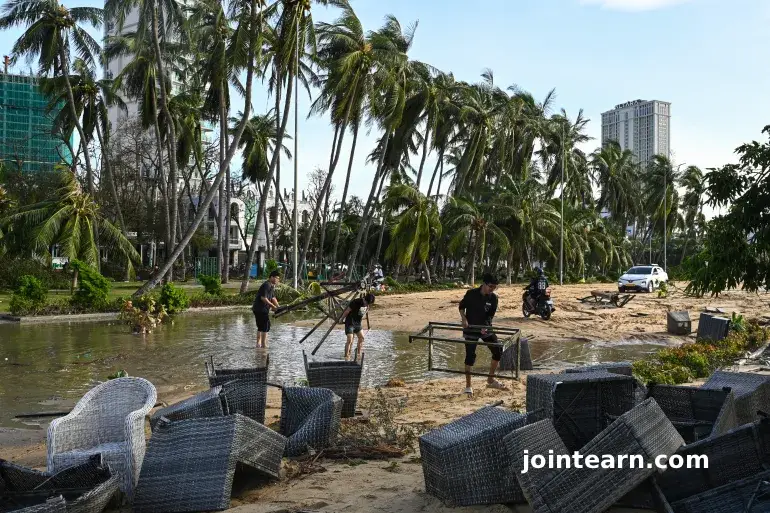
Deadly Typhoon Kalmaegi Slams into Vietnam
At least five people have been killed and more than a million households left without electricity after Typhoon Kalmaegi battered central and highland regions of Vietnam, unleashing torrential rain and destructive winds.
The Vietnam News Agency reported widespread devastation across multiple provinces after the storm made landfall on Thursday evening, bringing winds of up to 135 km/h (84 mph) and waves reaching 8 meters (26 feet) along the coast.
Kalmaegi is the 13th typhoon to form in the South China Sea this year, intensifying concerns about climate-related extreme weather in Southeast Asia.
Widespread Destruction Across Central Provinces
According to official reports, 57 houses collapsed completely, while more than 3,000 homes lost their roofs as powerful winds tore through Dak Lak, Quang Ngai, and Gia Lai provinces — among the hardest-hit regions.
The storm also caused the sinking of 11 fishing boats, extensive flooding in low-lying areas, and massive power outages that affected over 1.28 million households.
More than 8,000 residents were evacuated from vulnerable areas before the typhoon hit, while schools, airports, and ports across central Vietnam were temporarily shut down.
“The government has mobilized 268,000 soldiers and emergency workers for rescue and recovery efforts,” state media reported. “Restoring electricity and clearing roads are the top priorities.”
Heavy Rains and High Winds Cause Chaos
Typhoon Kalmaegi’s landfall brought sustained winds exceeding 100 km/h (62 mph) and intense rainfall, triggering landslides and flash floods in mountainous districts.
Meteorological agencies warned that rainfall totals in some central provinces may exceed 300 mm (11.8 inches), raising the risk of flooding and crop damage.
Roads linking major cities, including Da Nang and Quy Nhon, were blocked by fallen trees and debris, while power lines and communication networks were severely damaged.
The US Embassy in Hanoi issued a travel advisory, warning foreign nationals of dangerous conditions in coastal areas, including high surf and strong currents.
Typhoon Weakens Over Cambodia and Laos
By Friday afternoon, Vietnam’s weather bureau confirmed that Kalmaegi had weakened into a tropical storm as it moved inland toward Cambodia and southern Laos.
Despite the downgrade, heavy rains continue to affect Vietnam’s Central Highlands, posing risks of flooding, landslides, and agricultural losses in already-saturated areas.
Vietnamese authorities have urged residents to remain alert, especially in rural communities that may face secondary flooding as rivers swell downstream.
Kalmaegi’s Destruction in the Philippines
Earlier this week, Typhoon Kalmaegi wreaked catastrophic damage in the Philippines, where it killed at least 188 people and left 135 missing, according to the Philippine Office of Civil Defense.
The storm caused severe flooding, landslides, and infrastructure damage across central provinces, marking one of the deadliest natural disasters in the Philippines this year.
“Kalmaegi’s path shows how Southeast Asia remains highly vulnerable to the intensifying effects of climate change,” said Dr. Tran Minh Ha, a Vietnamese climatologist. “Each year, storms grow stronger and more unpredictable.”
Vietnam’s Growing Vulnerability to Typhoons
Vietnam and the Philippines are located along the Pacific Typhoon Belt, one of the world’s most active tropical cyclone zones. The region typically faces 10 to 15 typhoons annually, with increasing severity due to rising sea temperatures.
In recent years, Vietnam has invested heavily in early warning systems and flood mitigation infrastructure, but climate scientists warn that stronger storms could overwhelm even improved defenses.
The World Meteorological Organization (WMO) has highlighted Vietnam’s central region as one of the most climate-vulnerable coastal zones in Asia, urging greater resilience planning and international cooperation.
Government Response and Recovery Efforts
Vietnamese Prime Minister Pham Minh Chinh convened an emergency meeting early Friday to coordinate disaster relief and reconstruction efforts.
Authorities have dispatched military helicopters, boats, and trucks to deliver aid, food, and medical supplies to isolated communities. Power companies are racing to restore service to hospitals and water facilities.
Local media reported that international aid agencies, including the Red Cross and UNICEF, are preparing to assist with relief operations, particularly for children and elderly residents affected by flooding.
“We are committed to helping every affected family rebuild their lives,” said Le Van Thanh, head of Vietnam’s National Steering Committee for Disaster Prevention. “The next 72 hours will be crucial.”
Aftermath: A Regional Wake-Up Call
With at least five confirmed deaths in Vietnam and hundreds more in the Philippines, Typhoon Kalmaegi underscores the urgent need for regional climate adaptation measures.
Environmental groups have renewed calls for stronger early-warning systems, sustainable coastal management, and international climate funding to protect vulnerable communities in Southeast Asia.
As cleanup begins, officials warn that Vietnam’s storm season is far from over, with more typhoons expected before the year’s end.
“This disaster is another reminder that climate resilience is not optional — it’s survival,” said Dr. Nguyen Thi Hoa, an environmental policy researcher in Hanoi.

Leave a Reply